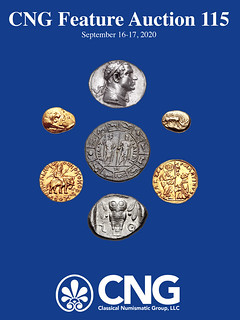
PREV ARTICLE
NEXT ARTICLE
FULL ISSUE
PREV FULL ISSUE
CLASSICAL NUMISMATIC GROUP SALE 115 ANNOUNCEDFor even more ancient coins to consider, here's the press release for the CNG fall sale closing September 16-17, 2020. Some great coins here. -Editor A Live Online Sale Closing Wednesday & Thursday, 16-17 September 2020
Our annual fall sale features Greek, Celtic, Oriental Greek, Central Asian, Roman Provincial, Roman Republican and Imperatorial, Roman Imperial coinage, and Romano-Byzantine Weights. Additionally, there are featured selections of Byzantine, Early Medieval and Islamic, World coinage and medals, British coinage and medals, Electrotypes & Reproductions, and Antiquities. CNG 115 is highlighted by a number of collections and individual rarities, which make up the majority of coins on offer:
• A Diverse Offering of Coins from the El Medina Collection
Catalogs for CNG 115 have been mailed to our active mailing list and bidding is open on the site. Some of the individual highlights from CNG 115 are: 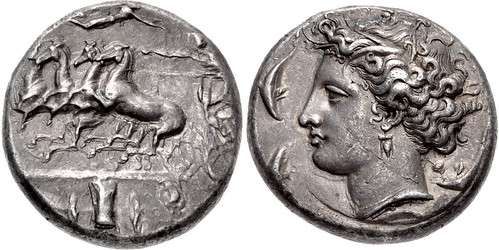
Lot 56–SICILY, Syracuse. Dionysios I. 405-367 BC. AR Dekadrachm (32mm, 43.34 g, 2h). Unsigned dies in the style of Euainetos. Struck circa 405-380/67 BC. Charioteer, holding kentron in extended right hand and reins in left, driving fast quadriga left; above, Nike flying right, crowning charioteer with wreath held in her extended hands; below heavy exergual line, [military harness, shield], greaves, cuirass, and crested Attic helmet, all connected by a horizontal spear; [AT?A below] / Head of Arethousa left, wearing wreath of grain ears, triple-pendant earring, and pearl necklace; S?-??-[?-?-S?O?] above, scallop shell behind neck, four dolphins swimming around. Gallatin dies R.XVIII/F.VIII; Scavino 53 (D16/R27); HGC 2, 1299; SNG Copenhagen 693 (same dies); SNG Fitzwilliam 1279 (same rev. die); SNG Lockett 991 (same rev. die); de Luynes 1247 (same rev. die). Toned, compact flan, minor die shift, flan flaws on reverse. NGC photo certified. Lot includes an NGC Photo Certificate, 4684186-001, grading the coin Ch XF, Strike: 4/5, Surface: 4/5, Fine Style, die shift. Estimated at $25,000 From the Grand Haven Collection. Ex Pegasi X (5 May 2004), lot 96. The engraver Euainetos seems to have begun his series of signed dekadrachm dies a few years after Kimon; perhaps he began as an apprentice and "graduated" to master status. His dekadrachm design superseded that of Kimon and became a paradigm for coinage throughout the classical world. His Arethousa is less human and more divine than his predecessor's vision. The wreath of grain ears woven into her hair symbolizes the agricultural bounty of Sicily. His racing chariot is the essence of action, almost photographically frozen in time, with the charging, rearing horses appearing to levitate above the ground line. The design was widely copied on later coinage of Syracuse, as well as by the Carthaginian forces in Sicily. 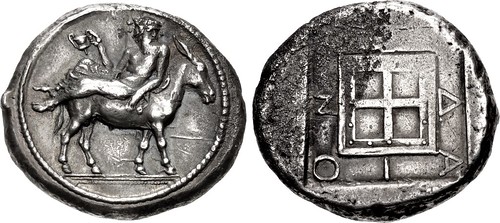
Lot 95–MACEDON, Mende. Circa 460-423 BC. AR Tetradrachm (26mm, 17.00 g, 12h). Inebriated Dionysos, wearing chiton draped from his waist, holding in right hand a kantharos propped on his right knee, reclining left, head right, on the back of an ass standing right / [MEN]-?A-I-ON within shallow incuse around quadripartite square in linear border ornamented with dots; all within incuse square. Noe, Mende 83 (this coin referenced); HGC 3, 548 (this coin illustrated); SNG ANS 345 (same dies); SNG Lockett 1352 (this coin); Jameson 1969 (same dies); Kraay & Hirmer 405 = GPCG pl. 10, 14; ACGC 462 = SNG Ashmolean 2303 (same dies). Old collection tone, area of light granularity, small area of flat strike on reverse. Good VF. Fine style. Estimated at $15,000 Ex Classical Numismatic Group 88 (14 September 2011), lot 85; Leu 20 (25 April 1978), lot 66; Munzen & Medaillen AG XXV (17 November 1962), lot 435; Richard Cyril Lockett Collection (Part VI [Greek Part II], Glendining, 12 February 1958), lot 1273; G. Empedocles Collection; 1913 Kaliandra Hoard (IGCH 358). 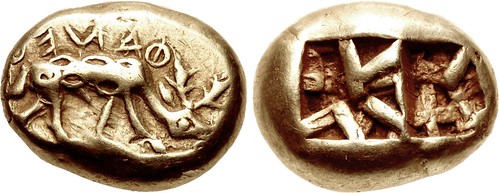
Lot 215–IONIA, Ephesos. Phanes. Circa 625-600 BC. EL Trite – Third Stater (14mm, 4.71 g). Stag grazing right, its dappled coat indicated by indentations on the body; FANEO[S] (retrograde) above / Two incuse squares flanking central incuse rectangle, each with raised intersecting lines within. Fischer-Bossert, Phanes 11b (O8/R20S&20L – this coin); Weidauer 40; SNG München 14; ACGC 54; GPCG p. 98, 3 = Kraay & Hirmer 585; Zhuyuetang 8. Lightly toned. Good VF. Well struck with a particularly clear inscription and stag. Very rare, with fewer than twenty trites of Phanes known. Estimated at $30,000 From the M.J.W. Collection. Ex Berk BBS 159 (28 April 2008), lot 1. The celebrated coins of Phanes – the first coins on which a legend appears – are known to be among the earliest of Greek coins, as a hemihekte (twelfth stater) of the issue was found in the famous foundation deposit of the temple of Artemis at Ephesos, built circa 550 BC. It is this find spot, along with the design of the grazing stag, that suggests Ephesos as the mint. If indeed a person, the mysterious "Phanes" named on this piece was likely an Ephesian treasury minister or a private individual wealthy enough to strike his own coinage. An alternative reading of the legend as "Phaneos" (light-bringer) has also been proposed, perhaps referring to an aspect of Artemis or her brother, Apollo. 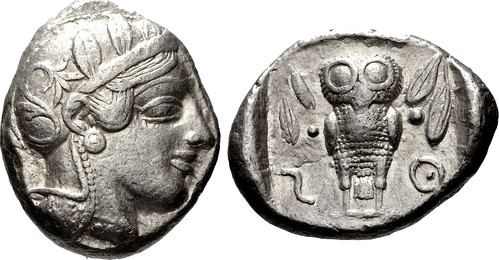
Lot 350–PHILISTIA (PALESTINE), Gaza (‘Azah) Mid 5th century-333 BC. AR Tetradrachm (21mm, 17.43 g, 9h). Imitating Athens. Head of Athena right, with frontal eye, wearing earring, necklace with pendants, and crested Attic helmet decorated with three olive leaves over visor and a spiral palmette on the bowl / Owl standing facing, wings folded; olive sprigs in upper corners, ‘AZ (in Phoenician) across lower field; all within incuse square. Gitler & Tal V.5Ta = SNG ANS 1 = SNG Berry 701 = Van Alfen, Two, p. 65, 9 = Mildenberg, Gaza, pl. 4, 1 (same dies); HGC 10, 532 (same dies as illustration); BMC Palestine pl. 42, 1 = Mildenberg, Money, pl. 1, 5 (same obv. die); Boston MFA 2203 = ACGC 207 = Svoronos, Monnaies pl. 110, 49 (same obv. die); Heritage 3075, lot 32034 (same dies); Künker 280, lot 264 (same dies); NAC 64, lot 1528 (same dies); Triton XXII, lot 388 (same obv. die). Slight die wear, minor marks, slight weakness at center of reverse. VF. Extremely rare. Apparently the eighth known, with only five examples recorded, three of which are in museum collections (ANS, Boston, and Berlin [the latter illustrated in Mildenberg, Money, and BMC]). Estimated at $10,000 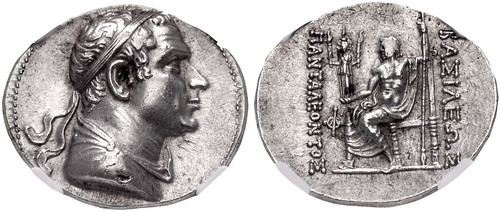
Lot 398–BAKTRIA, Greco-Baktrian Kingdom. Pantaleon Soter. Circa 185-180 BC. AR Tetradrachm (31mm, 16.88 g, 11h). Diademed and draped bust right / BASI?EOS to right, ?ANTA?EONTOS to left, Zeus enthroned left, holding in right hand statue of Hekate, who holds torch in each hand, and scepter; monogram to inner left. Bopearachchi 1A = MIG Type 157a = HGC 12, 100 (same dies as illustration); Bopearachchi & Rahman 168 (same obv. die); SNG ANS –; Zeno –; NAC 77, lot 107 (same dies). In NGC encapsulation 5768164-002, graded Ch AU?, Strike: 4/5, Surface: 4/5, Fine Style. With an attractive, high-relief portrait. Extremely rare and among the finest known. Estimated at $50,000 Known only from his coins, the identity of this Greco-Bactrian king has long been a subject of debate. Some nineteenth century scholars, who were working with a more limited selection of coins, believed that Pantaleon, along with Agathokles, was a son of Diodotos I. But as more numismatic evidence came to light, it was clear that kings such as Agathokles, Antimachos, and Pantaleon could not be part of the Diodotids who ruled in the early period of Baktrian independence from the Seleukids. The coinages of Pantaleon and Agathokles are similar in many respects, leading some authorities to suspect that they were relatives. The portrait on this tetradrachm, for example, is closely linked to those of Agathokles, suggesting there was an effort to demonstrate unity or solidarity. Pantaleon's well-modeled image is somewhat older and heavier than that of Agathokles, and has a less pronounced chin. A further indication that Pantaleon and Agathokles were closely associated is the fact that Agathokles struck pedigree tetradrachms for Pantaleon (as savior). This would suggest that Pantaleon was either a predecessor or a contemporary who died before Agathokles, whose coinage demonstrates that his reign was significantly longer than that of Pantaleon. The five examples of this issue are known from one obverse and three reverse dies:
1. A/a
2. A/b
3. A/c
Enigmatic Crawford 482/1 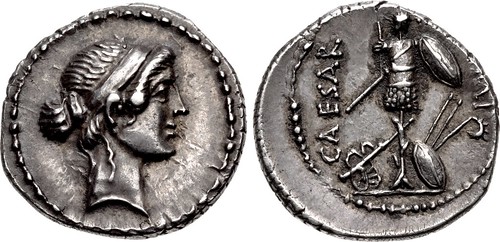
Lot 606–The Triumvirs. Octavian. Spring 43 BC. AR Denarius (18mm, 3.62 g, 12h). Military mint traveling with Octavian in Italy or Cisalpine Gaul. Head of Venus (with features of Apollo) right, wearing fillet, her hair collected into a knot behind / Trophy of Gallic arms, chariot at base on left, a shield, two spears and carnyx on right; CAESAR upward on left, [I]MP downward on right. Crawford 482/1; CRI 130; Sydenham 1016; RSC 15 (Caesar); RBW 1696. Lovely old cabinet toning, reverse struck slightly off center with some deposits in the devices. EF. Very rare and among the finest known. Estimated at $30,000 Ex Gemini V (6 January 2009), lot 783; Naville X (15 June 1925), lot 1737. Considered by Crawford as the last denarius minted by Julius Caesar, David Sear considers it the first military issue of Octavian. For further discussion on this enigmatic type, see the commentary by Andrew McCabe for his specimen that we sold in CNG E-Auction 432 (November 2018), lot 271. 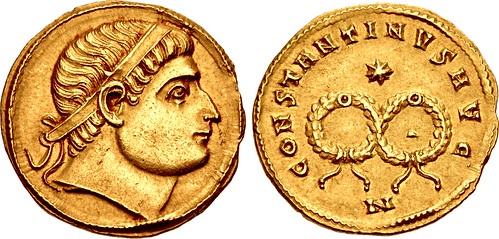
Lot 719–Constantine I. AD 307/310-337. AV Solidus (19mm, 4.50 g, 6h). Nicomedia mint. Struck AD 326. Head right, wearing plain diadem, eyes to God / CONSTANTINVS AVG, two interlaced wreaths; star above; N. RIC VII 109; Alföldi 41; Depeyrot 38/2; Biaggi –; Mazzini –. A few faint scratches and marks, tiny obverse die break. EF. Very rare. Exceptional portrait. Estimated at $15,000 Ex Numismatica Ars Classica 102 (24 October 2017), lot 582 (24,000 CHF); Roma I (15 October 2010), lot 517; Hess-Leu 36 (17 April 1968), lot 556. 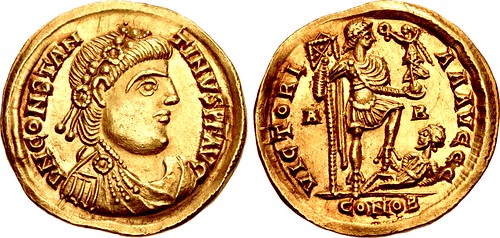
Lot 744–Constantine III. AD 407-411. AV Solidus (21.5mm, 4.44 g, 6h). Arelate (Arles) mint. D N CONSTAN TINVS P F AVG, rosette-diademed, draped, and cuirassed bust right / VICTORI A AAVGGG, Constantine III, laureate and in military attire, standing right, holding vexillum in right hand and Victory on globe in left hand, with his left foot he treads down a seated captive; A|R//CONOB. RIC X 1519; Ferrando p. 343, 1701 (this coin illustrated); Depeyrot –; Biaggi –. Lustrous, traces of earthen deposits. EF. Very rare. Estimated at $15,000 Ex Numismatica Ars Classica 52 (7 October 2009), lot 653 (hammer 18,000 CHF); Property of an European Nobleman (Numismatica Ars Classica 24, 5 December 2002), lot 334; Superior (11 December 1992), lot 2553; Clarence S. Bement Collection (Ars Classica VIII, 25 June 1924), lot 1581. 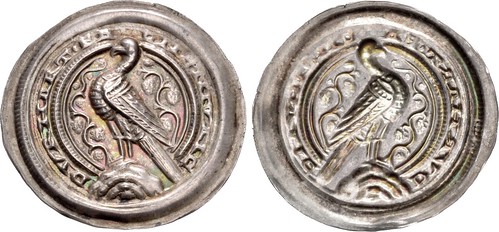
Lot 861–GERMANY, Falkenstein (Grafschaft). Burkhard II. 1142-1174. AR Bracteate (29mm, 0.81 g). Ermsleben mint. DVRH?RT • F? • • LNSNIV?C, eagle standing left on rock / Incuse of obverse. Kestner 1445; Bonhoff –; Löbbecke 231. Wonderful cabinet toning. Choice EF. Very rare. Estimated at $10,000 From the Dr. William J. Conte Collection of Bracteates. Ex Dr. Helmut Hahn Collection (Künker 301, 1 February 2018), lot 545. 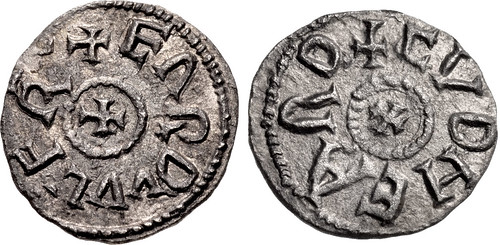
Lot 1005–ANGLO-SAXON, Kings of Northumbria. Eardwulf. First reign, 796-806. AR Sceatt (13mm, 0.99 g, 3h). York mint; Cuthheard, moneyer. + E?RDVVL·F R, cross pattée in dotted circle / + CVDHEARD, cross pattée in dotted circle. Pirie, Guide 3.2a var. = E.J.E. Pirie, "Earduulf: a significant addition to the coinage of Northumbria" in BNJ 65 (1995), pl. 2, 12 var. (no circle on rev.; same obv. die as illustration); Sceatta List 86-10 (same dies as illustration); North –; SCBC 858. Near EF. Struck on a full flan in unusually good metal. The finest known example of this great Northumbrian rarity. Estimated at $10,000 Eardwulf acceded to the Northumbrian throne in the tumultuous period following the assassination of Aethelred I in 796. Eardwulf had helped organize the murder of Aethelred in revenge for Aethelred's earlier, nearly successful, attempt on Eardwulf's life. Eardwulf's reign was characterized by conflict with Coenwulf of Mercia who gave asylum to his enemies. In the late eighth century, close ties existed between the Northumbrian and Frankish courts and it may have been that Eardwulf married an illegitimate daughter of Charlemagne. Eardwulf was deposed in 806 by the shadowy Aelfwald II and went on pilgrimage to Rome and visited the Emperor's court in Nijmegen. Frankish sources suggest he may have reclaimed his kingdom in circa 808 before being succeeded by his son Eanred, possibly around 810. No coins were known of Eardwulf before the Burton Fleming find in 1994 (EMC 1995.6001; Pirie, BNJ 1995, pp. 20-31). This is the only second coin of Eardwulf to be offered for sale in a public auction (the first was in CNG 114, lot 1245 [hammer $9500]). Printed catalogs for CNG 115 are now available. To order the catalog, please call our U.S. office at (717) 390-9194. Catalogs have been mailed to customers on CNG's active mailing list. Prospective bidders may also view the virtual catalogs at https://issuu.com/cngcoins/docs/cng_115_virtual_catalog. The sale can be viewed online at auctions.cngcoins.com, sixbid.com, and numisbids.com. In addition to CNG Feature Auction 115, CNG will also feature over 900 lots from many of the same collections listed above in their Electronic Auction 477, closing one week later on Wednesday, 23 September 2020, from 10AM ET (U.S.). Bidding for CNG Electronic Auction 477 will begin on 9 September 2020. CNG is currently accepting consignments for future auctions sales. Please contact the firm for further details and consignment deadlines. For further details and any additional information, please contact CNG, LLC at:
Classical Numismatic Group, LLC

Wayne Homren, Editor The Numismatic Bibliomania Society is a non-profit organization promoting numismatic literature. See our web site at coinbooks.org. To submit items for publication in The E-Sylum, write to the Editor at this address: whomren@gmail.com To subscribe go to: https://my.binhost.com/lists/listinfo/esylum All Rights Reserved. NBS Home Page Contact the NBS webmaster 
|
